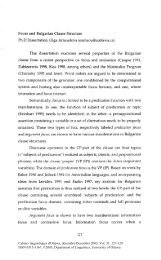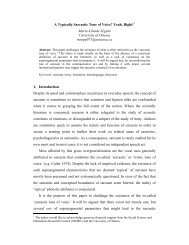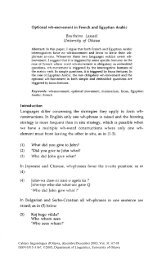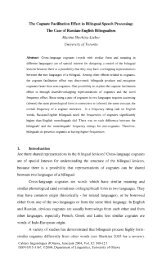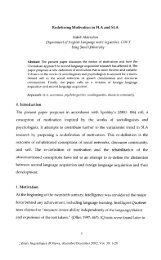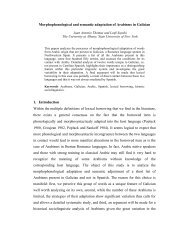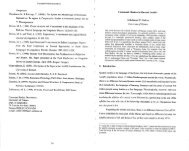Interlingual and Intralingual Interference during Gender Production
Interlingual and Intralingual Interference during Gender Production
Interlingual and Intralingual Interference during Gender Production
You also want an ePaper? Increase the reach of your titles
YUMPU automatically turns print PDFs into web optimized ePapers that Google loves.
Denisa Bordag<br />
name <strong>and</strong> word distractor in the first language experiments were usually<br />
semantically unrelated words, the two translation equivalents are semantically<br />
identical (or at least very close) <strong>and</strong> share a common concept. Consequently, it<br />
might be the case that the competition between gender nodes is stronger if the<br />
two relevant lemmas share the same concept <strong>and</strong> that under this condition the<br />
not-to-be-selected gender node interferes <strong>and</strong> competes for selection even when<br />
it is not needed by the syntactic environment. More experiments are, however,<br />
necessary in order to explain the difference between the two effects satisfactorily.<br />
3. <strong>Intralingual</strong> interference<br />
In the next step, the role of intralingual interference <strong>during</strong> second language<br />
production of grammatical gender shall be explored. According to Richards<br />
(1971) intralingual interferece "reflects the general characteristics of rule<br />
learning such as a faulty generalisation, incomplete application of rules <strong>and</strong><br />
failure to learn conditions under which rules apply". A typical manifestation of<br />
an intralingual interference is thus overgeneralization.<br />
As already mentioned above, the gender of German <strong>and</strong> especially Czech<br />
nouns can be partly derived from a word's termination. In Czech, there is a<br />
typical termination for each gender (monomorphemic words): -a for feminines, <br />
o for neutrals <strong>and</strong> a consonant for masculines, in German this is only partly true<br />
(see below). In both languages it is, however, possible to formulate rules on the<br />
basis of which a large number of nouns can be assigned a particular gender<br />
according to their termination. One way in which intralingual interference <strong>during</strong><br />
second language production can be manifested is hence overgeneralization of<br />
these regularities between a noun's grammatical gender <strong>and</strong> its termination. To<br />
find out whether this kind of intralingual interference appears in the data, the<br />
gender errors made in the long conditions in both experiments were analyzed.<br />
4.1 <strong>Gender</strong> errors analysis<br />
A detailed analysis of gender errors made by subjects in both experiments in the<br />
long condition revealed a consistent pattern: Subjects made most gender errors in<br />
agreement with nouns which had either an ambiguous or an atypical termination<br />
14



